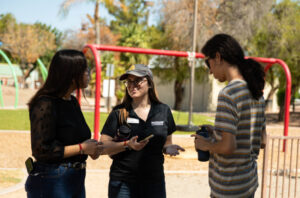The City of Chandler hosts a robust park system, with over 60 public parks that provide residents and visitors access to outdoor green space and recreation opportunities throughout the community. Through its priority areas, the City invests in an expansive network of neighborhood and community parks to enhance quality of life and social cohesion. As the City continues to grow, maintaining and enhancing its reputation as a livable community is paramount to leadership, and its broad network of parks is one of the City’s community-embedded assets.
Neighborhood and community parks serve a diverse population through green spaces, recreational activities, and sports facilities. The City’s community parks, including Tumbleweed and Desert Breeze, serve as community hubs for recreation and play; while its neighborhood parks serve the local neighborhood. With a goal of at least one neighborhood park per square mile of residential development, when possible; the City is interested in evaluating its park usage to determine best how to continue providing high-quality recreation resources.
Undergraduate students from the School of Sustainability collaborated with the Chandler Community Services Department to evaluate five Chandler neighborhood and community parks. The students used an evaluation tool, the System for Observing Play and Recreation in Communities (SOPARC) framework, to assess park usage and equity and provide recommendations on improvements for the City. Students conducted field observations of park usage at their assigned park over the course of six weeks, culminating in an analysis of park user demographics, physical activity, and environmental factors.
Park usage and observations indicate that the selected neighborhood parks experience a consistent amount of park usage throughout the week, particularly in the playground areas and walking paths. The community parks experience an increase in usage on the weekends, mostly for organized sports and other recreational activities. The parks are currently well-maintained, while the shade and playground infrastructures can be improved through routine maintenance and improved shade coverage. The City can further invest in its parks by establishing park-specific community groups, such as “Friends Of” organizations, for regular park users and community members to collaborate and co-develop special projects for park improvements. Additionally, the City can develop educational and interactive programming and signage to highlight the City’s commitment to the environment and sustainability.
By ensuring that all community members have access to safe, accessible park spaces, the City of Chandler can continue to serve its residents by providing connectivity, improved quality of life, and neighborhood vitality. The City’s parks serve as critical physical and social spaces for leisure and recreation, highlighting the importance of community investment and engagement in ensuring an equitable future as the community continues to grow and innovate.
